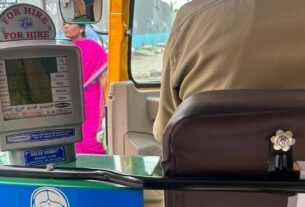The art of preserving heritage sites is much more difficult than it seems. In the process of their restoration, there have also been instances of loss of originality and ancient touch of the murals.
By Surbhi Shah
Bengaluru, February 25, 2020
Re-constructing ancient sites of importance without losing their essence is a much more difficult task than what Senil Kumar had anticipated before migrating from a Tamil Nadu village to Bengaluru.
Hired for re-painting the Tirupati Balaji temple in K.R. Market, Senil’s hands skilfully moved across his painting as he observed his master piece—which will be placed high on the temple wall, without anyone knowing the artist behind it.
“My mates and I started working on this site two weeks ago. The base has been put up and now we are colouring the murals,” said Senil Kumar while balancing himself on a bamboo structure, with a paint brush stuck between his teeth and a colour bucket between his fingers.
Laxmi, a worker in the temple said, “The building was starting to look very bad. It had degraded and turned black on the yellow marble stone, so the temple authority decided to re-paint it.”
The temple is declared as a protected ancient monument under Section 3 of the Karnataka Ancient and Historical Monuments and Archaeological Sites and Remains Act 1961.
Though the re-construction of the heritage sites is important in order to conserve the history and culture, many people believe that the sites are losing their ancient charm. They believe that the use of present- day colours and tools for restoration make the murals seem vandalised.
“Earlier when we used to see the monuments and temples, all had such different architecture and carvings, but now all the murals look the same—same colour, same faces and same design. It is scrapping out the old and rustic look of the monuments,” said Hiral, a tourist from Indore, Madhya Pradesh who was walking down the Bengaluru Fort steps, taking a city tour.
She added that the Bengaluru Fort—which was under construction months back for re-building its temple looked the opposite. “The fort is an ancient monument and the newly built temple looks so modern. It takes away the vibe,” said Hiral.
Nagraj Sharma, a researcher of arts and archaeology believed that the sites shouldn’t be repainted at all, and that the process for restoration is given under the Archaeological Department guidelines.
“It is not important what materials we use because we have to preserve the original paintings. The mentality of the current artist is not the same as that of the original. So we should refrain from repainting them,” he said.

However, in some places, the old techniques of restoration are still in practice where the base of the wall is made using chuna, jaggery water, etc to restore the ancient touch of the monuments.
“We had re-painted a temple and a palace in Indore and Bhopal. The base is made differently and the painting is done on a slightly wet base, as contrary to the normal painting done on the dry base. Stone colours are used and they are mixed with a preservative chemical that helps keep them on for at least 20 to 25 years,” said Chainika Khona, a student artist in Madhya Pradesh.
In addition to it, remaking something, especially the art and architecture of the ancient heritage buildings in India, is not a cake walk.
Chainika said that the chemical mixed is expensive in India and that they import it from England for Rs. 18,000 per kg. “For painting 30 to 40 feet we need only grams of the chemical so it works, but it is expensive for larger projects,” she added.
The project was led by Chainika’s professor—Manoj Kumar Upadhyay, which was given to him under a government tender.
Apart from painting, re-construction of heritage buildings in Bengaluru is also under way. The project of Bengaluru Gate is currently taken up by the Indian National Trust for Art and Cultural Heritage (INTACH).
The reports show that around Rs.50 lakh were used to restore the century old monument. “Our team is currently working on the project and it may be done within two to three months,” said Meera Iyer, convenor, INTACH.




